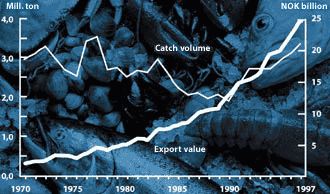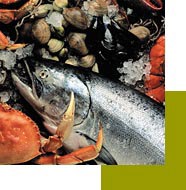Business and industry in Norway - The food, beverages and tobacco industry
Brosjyre/veiledning | Dato: 28.06.2001 | Nærings- og fiskeridepartementet
Opprinnelig utgitt av: Nærings- og handelsdepartementet
| Number of companies | 1655 |
| Number of employees | 53 160 |
| This sector’s export share | 3 |
| Gross product in percentage | 2,0 |
The Norwegian food, beverages and tobacco industry has grown gradually since the end of the 19th century and is currently Norway’s second-largest industrial sector. These companies mainly process Norwegian agricultural and fisheries products. The industry’s structure is to a large extent influenced by agricultural-policy and fishing-policy regulations. There are some large groups of companies in this industrial sector, such as Orkla, but most of the companies are small or medium-sized. The agriculture-based food and beverages industry primarily targets the domestic market. The fishing industry, on the other hand, exports more than 90 per cent of its output.
The meat industry consists of Norsk Kjøtt, a farmer-owned slaughterhouse cooperative, and independent processing companies. Almost all Norway’s meat consumption is covered by Norwegian producers, with the exception of some beef that is imported duty-free from Botswana and Namibia.
The fishing industry’s output is based on raw materials from Norwegian and foreign catches and from Norway’s fish-farms. The output from Norwegian fish-farms increased considerably in the 1990s and salmon is now one of the country’s largest exports. Fish-farming probably has an extremely large growth potential, both as regards the current types of species farmed (salmon and trout) and new types (shellfish, catfish, halibut). Fish-farming is mainly based on Norwegian-produced fishmeal, which utilises raw materials from the Norwegian herring-meal and oil industries. The herring-meal industry takes and processes more than 50 per cent of all the fish landed in Norway. The dairy industry primarily produces milk, yoghurt, butter and cheese. Most of the dairy companies are members of Meierisamvirket, the dairy cooperative, but competition has increased over the past few years. A relatively small company , Synnøve Finden AS has captured 10 per cent of the market for cheese and there are also other independent dairies. The dairy industry exports relatively large amounts of Jarlsberg cheese.
Other food and beverages companies produce bakery products, chocolate and confectionery goods, beverages, oil and lard. The bakery products primarily consist of bread, pizzas and cakes. Chocolate and confectionery goods mainly comprise chocolate and pastilles, and this market is dominated by Freia and Nidar Bergene.
The beverage industry produces beer and mineral water, with around three-quarters of its employees involved in brewery operations. Other companies produce various ready-made foods, such as soups, sauces, salads, snacks and coffee. These mainly supply the Norwegian market, where they compete with imported goods made by large foreign companies. Some Norwegian companies have, however, expanded into the Scandinavian market.
| Company | Product |
| Stabburet (Orkla) | Meat products |
| Norway Seafoods, Findus Norge, | Fish products |
| TINE Norske Meierier, Gausdalsmeieriet | Milk |
| TINE Norske Meierier, Synnøve Finden A/S | Cheese, etc |
| Bakers (Orkla), Goman | Bread |
| Kraft Foods, Nidar (Orkla), Brynild, Minde Sjokoladefabrikk | Chocolate, pastilles |
| Ringnes(Orkla), Hansa Borg, Mack | Mineral water, beer |
| Toro (Rieber) | Soups and sauces |
| Pronova Biocare | Fishmeal and oil |
| JL Tiedemanns Tobaksfabrik | Tobacco |
|
The catch volumes and their export value (fish-farmed salmon is included). The export of Norwegian fish and fish products has increased sharply since the beginning of the 1970s, and reached NOK 30 billion in 1999. Salmon exports comprise 31 per cent of Norway’s total export of fish and fishing products. According to the FAO statistics for 1997, Norway is the world’s largest exporter of seafood. Sources: Foreign Trade Statistics, Statistics Norway and the Norwegian Directorate of Fisheries.
Export share of the agricultural-based food industry (ex. fish). Back >
|
|
|
| |||
The food, beverages and tobacco industry | ||||



